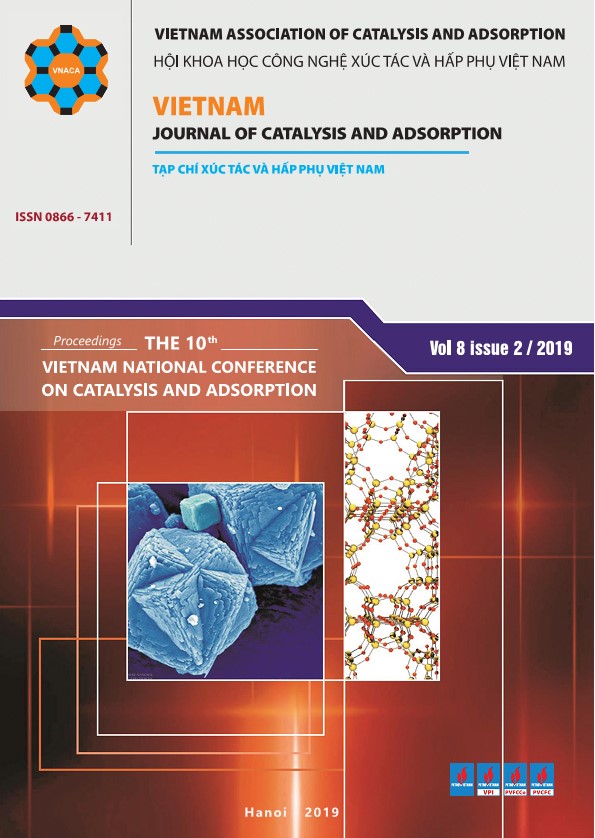Synthesic of carbon aerogel materials from coal and orienting for oil recovery
Abstract
This paper presents the results of carbon aerogel preparation by hydrothermal methods and structure of the as-synthesised carbon aerogel by chemical-physical characterisation methods such as XRD, SEM, FT-IR, EDX, and BET. The sample shows a high adsorbability, the results of evaluation of the parameters of oil adsorption process show that at the temperature of 30oC, 1 gram of carbon aerogel is capable of adsorbing 5.78 grams of oil in 40 minutes.
Downloads
References
Abdul Aziz Al-Majed, Abdulrauf Rasheed Adebayo, M. Enamul Hossain, Journal of Environmental Management, 113 (2011) 213-227.
Vũ Thị Thu Hà, Nghiên cứu chế tạo vật liệu mới hấp phụ chọn lọc dầu trong hệ đầu nước có khả năng ứng dụng trong quá trình tách chất và trong xử lý sự cố tràn dầu, Viện hóa công nghiệp Việt Nam, Đề tài cấp bộ công thương số 02-11 HT/HĐ-KHCN), (2011).
Hoàng Thị Phượng, Nghiên cứu tổng tợp và biến tính vật liệu nano silica ứng dụng cho quá trình thu hồi dầu, Luận án Tiến sỹ, Trường Đại Học Bách Khoa Hà Nội (2018).
Nguyễn Đình Dương, Hồ Lệ Thu, Lê Vân Anh, Nguyễn Kim Anh, Tạp chí Các Khoa Học Về Trái Đất, số 35(4), (2013), 424-432.
Nguyễn Đình Dương, Ô nhiễm dầu trên biển và quan trắc bằng viễn thám siêu cao tần. Nxb. Khoa học và Kỹ thuật, Hà Nội, (2011), 107-137.
. Bharat Bhushan (Ed.), Springer Handbook of Nanotechnology, 2004.
Natalia Martini and Admiral Roberto Patruno, Oil pollution risk assessment and preparedness in the east Mediterranean. International Oil Spill conference. Miami, USA, (2014) 15-19.
Q. Lin, I.A. Mendelssohn, K. Carney, N.P. Bryner, W.D. Walton, In-situ burning of oilin coastal marshes. Oil spill cleanup efficiency as a function of oil type, marsh type and water depth,Environ. Sci. Technol., 39 (2005) 1855.
P. Li, Y. Zhang, M. Li, B. Li, Bioremediation of oil containing seawater by membraneaerated biofilm reactor, Ind. Eng. Chem. Res., 54 (2015) 13009–13016.
V. Broje, A.A. Keller, Improved mechanical oil spill recovery using anoptimized geometry for the skimmer surface, Environ. Sci. Technol.40 (2006) 7914–7918.
L. Jian, Y. Long, T. Xiaohua, F. Hua, H. Dongcheng, Z. Fei, Robust superhydrophobicfabric bagfilled with polyurethane sponges used for vacuum-assisted continuous and ultrafast absorption and collection of oils from water, Adv. Mater. Interfaces, 3 (2016) 1500770.
Lazaro, G. Quercia, H.J.H. Brouwers, and J.W. Geus, Synthesis of a green nano-silica material using beneficiated waste dunites and its application in concrete. World Journal of Nano Science and Engineering, 3(3) (2013), 341-351.
Shervin Kabiri, Diana N.H. Tran, Tariq Altalhi, Dusan Losic, Outstanding adsorption performance of graphene–carbon nanotube aerogels for continuous oil removal, Carbon, 80, (2014) 523-533.
Jianliang Xiao, Jifei Zhang, Weiyang Lv, Yihu Song, Qiang Zheng, Multifunctional Graphene/Poly (vinyl alcohol) aerogels:In situ hydrothermal preparation andapplications in broad-spectrum adsorption for dyes and oils, Carbon, 123, (2017), 354-363.
Pekala R. W. Organic aerogels from the polycondensation of resorcinol with formaldehyde, Journal of Materials Science, 24(9), (1989) 3221–3227.
Hajar Maleki. Recent advances in aerogels for environmental remediation applications: A review, Chemical Engineering Journal, 300 (2016) 98–118.
Published
Issue
Section
License

This work is licensed under a Creative Commons Attribution-NonCommercial 4.0 International License.











